
How To Get The Most Out Of Your Social Media Strategy
A great social media strategy is the driving force behind successful digital marketing. Social Media can propel your business into a position of greater visibility, more customer success stories, and promote the content on your site. Learn how to avoid common pitfalls to get the most out of your social media strategy.
1. Be Where You Belong
Just because the network exists doesn’t mean you should be broadcasting on it. Think about the space where you are promoting yourself and if that space is right for your messaging. For example, B2C does much better on Facebook than it does on LinkedIn, where B2B tends to shine. On LinkedIn, business owners tend to share in-depth articles and slideshares to brand themselves as thought leaders in their respective industries. It’s not the first place business owners go to mention a sale they are running this week (or at least it shouldn’t be). For that kind of post, the consumer-oriented Facebook is a better bet, where people tend to pass around events and sales more.
Take a look at a breakdown of the numbers:


DATA SOURCE: SOCIALMEDIAEXAMINER.COM
2. Be Complete & Accurate
I work with a lot of local small/medium businesses. One of the main problems I see is incomplete or inaccurate social profiles and local listings. This is something I work on fixing immediately. It’s an especially crucial step for local businesses that rely on their physical location to serve clients. Google may choose not to list you in the local “6-pack” if you have inaccurate data spread around the internet. The “6-pack” is a prime piece of local search engine real estate I work on to gain visibility for my clients.

For example, if your Facebook page lists your suite number, you need to make sure your Google Local page also includes that suite number. Second, make sure that fields for your website URL, phone number, store hours, and similar are complete and accurate across listings. Data inconsistencies will keep you from ranking well, but it’s also your chance to make a good first impression on potential customers.
3. Create Goals & Measure Success
We’ve all heard the famous Yogi Berra quote, “If you don’t know where you are going, you’ll end up someplace else”? Nothing could be truer when it comes to your social media strategy! It’s important to think through strategic objectives and define what success means before proceeding. What do you want from your social efforts? Brand development? Customer engagement? Define key metrics in your strategy and then you or your digital marketing specialist can report on them monthly so you can be sure you are meeting your goals. You can use Google Analytics and Facebook Insights to track the results you care about and how those results are being achieved.
Engagement details:

MEASURING WHAT MATTERS & REPORTING ON THOSE METRICS MONTHLY
Where is the most engagement coming from:
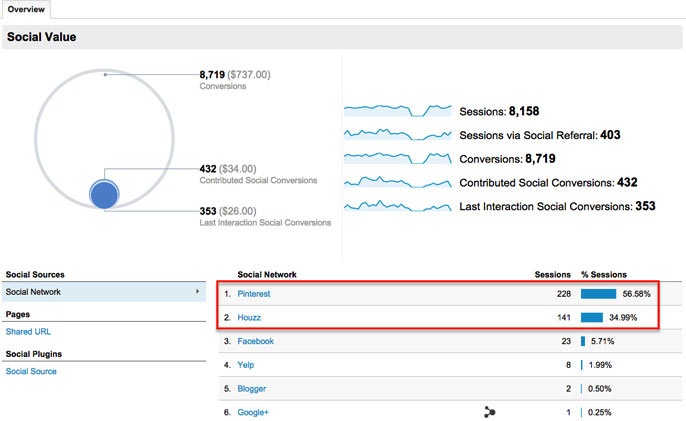
PINTEREST & HOUZZ ARE CONTRIBUTING THE MOST ENGAGEMENT SESSIONS
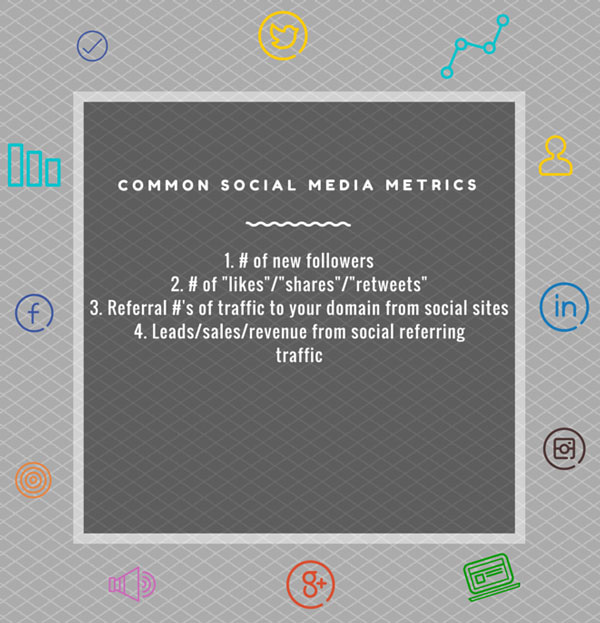
4. Make Your Social Stick
Data shows that users interact with the top left side of a webpage the most, according to a heatmap visualization done in 2006. The study shows that users read pages in a “F formation” — starting in the top left, top middle, then vertically down the page. Placing your social media buttons to stay fixed in the top left quad of your site while readers scroll down the page increases share rates.
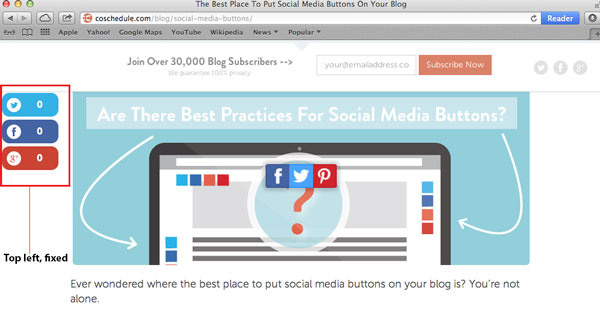
5. Give Your Content “Shareability” Factors
“Shareability” isn’t a measurable thing, right? We aren’t really conscious of all the factors that compel us to share content online. But when you think about what actually gets shared, it usually has these attributes:

There has been a lot written on these topics already, so I won’t go into too much detail, but I’d like to impart an idea about each of the shareability factors.
1. Attention-Grabbing Title – There is a science and psychology behind writing clickable headlines. Copyblogger has literally written the book on the subject. I would head there to familiarize yourself with formulas that work.
2. A Unique Topic – It’s smart to write about topics that are popular in your industry. Just make sure you are adding something to the conversation by approaching it from a new perspective or contributing a new idea.
3. Knowing Your Audience – This is a pretty big deal. You must do some demographic research and define at least the basic characteristics of your ideal customer. This way you can speak directly to them, which greatly increases the chances of them sharing your content, or better yet earning them as a customer. If you want to experiment with creating buying personas yourself, FAKE CROW has some free interactive templates you can work with.
4. Clear & Concise Language – Don’t be too jargony, speak in a way that is meaningful to your audience and communicates your message effectively.
5. High-Quality Graphics & Images – It’s a well established fact that people don’t read, they scan. And nothing is more un-scannable than huge blocks of text on a page. If you want people to make it to the bottom of your page, give them something more visually interesting to look at.
6. Be An Interesting Character
If you are only promoting what you want to sell on social media, eventually followers will begin to tune you out. Be impossible to ignore by being more than a salesperson — be an interesting character! Engage in conversations with followers, be willing to help them solve problems, share their stuff. You can add value in a number of different ways: by being funny, running a contest or giveaway, or by being controversial. Once you set the tone and the schedule, keep it consistent across all your profiles. No one could argue that Andrea Heimer has uninteresting painting titles. Check out the title below. Her art isn’t hard on the eyes, either!

7. Monitor Your Profiles
Keeping an eye on what’s happening on your social feeds is a good habit to get into. You want to make sure that you are addressing feedback (positive or negative) in a timely manner. Many customers will turn to social media to voice complaints, since they know that public forums will get the attention of business owners a lot quicker than traditional channels. In the example below, FishsEddy responds to a customer question on Instagram and provides an alternative way to use their vintage-inspired sugar bowls.

8. Have A Crisis Management Plan & Share Guidelines With Employees
If you’re online long enough, chance are you will have some bad social interactions. Be prepared to deal with some negativity. Detractors love to have their voices heard in public forums, so it’s a good idea to have a plan to address this before it happens. Figure out who the person is and why they are upset, then craft a conscientious response, ideally within 24 hours of the incident. You should also research and formulate what to do and who can assist you if your site goes down or is hacked. You can’t control everything, but you can control how you respond. Make sure you share the “crisis management plan” with employees, so that they are empowered to help protect your reputation. Small businesses can take processes used by larger organizations and scale them to work for their needs. Social Media Examiner illustrates how to write an employee-centered social media policy that works for everyone: business owner > employee > customer.
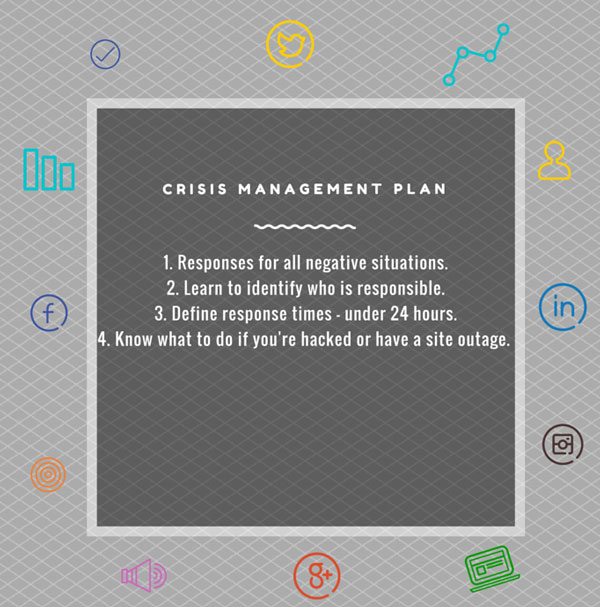
9. (Free) Tools Of The Trade
If you’re like me, you’re always looking for the best free tools you can use that allow you to upgrade as you grow.
These are tools I personally use to develop content for clients and manage their social media profiles. I can vouch for their awesomeness.
- Buffer – The one and only (in my opinion) for small business social media management. You can connect up to four accounts and schedule all your posts in advance, including the time of day they go out. If you’re short on content for the week, they offer story suggestions you can add to your queue to keep it topped off.
- Mention – I used to use Mention to monitor brand mentions and/or industry news for my clients. It allows you to monitor the web for mentions of you or your brand, and/or topics you’re following and receive email alerts, and slack notifications, so you can monitor everything in one place.
- Feedly – Curate content from all the valuable sources on the web in one place. Integrate with Buffer.
- Pocket – use the browser extension to “pocket” articles you have read throughout the month for your social media curation or to populate a monthly newsletter. Also integrates with Buffer via IFTTT.
- Google Trends – Great in helping you identify keywords to include in your content and can be useful in generating content ideas. I’ve also used this in the past to illustrate seasonal declines around categories and keywords, if for instance, there is a drop in traffic month over month.
- Google Analytics – This is how you measure the effectiveness of everything you’re doing. Measure your social referrals, your traffic, or just about anything else you want to keep an eye on. This is also my go-to tool for monthly client reporting.
- Facebook Insights – If you are doing any marketing on Facebook, then this is their free analytics tool that will help you monitor and measure campaign metrics – likes, shares, engagement, post reach, etc. If you are actually paying for advertising on Facebook, then this is a must-have free tool for the toolkit.
10. Do’s & Dont’s
Social media can be the driving force behind your digital marketing strategy. It can define your brand, build your reputation, and introduce you to wider audiences. It can be a win-win for everyone, but it requires planning and strategy. Here are some final do’s and don’ts to keep in mind. I recommend working with a strategist to define a social media style guide before you post anything to a single profile. Get your do’s and don’t down on paper before you hand over your usernames and passwords to your team.
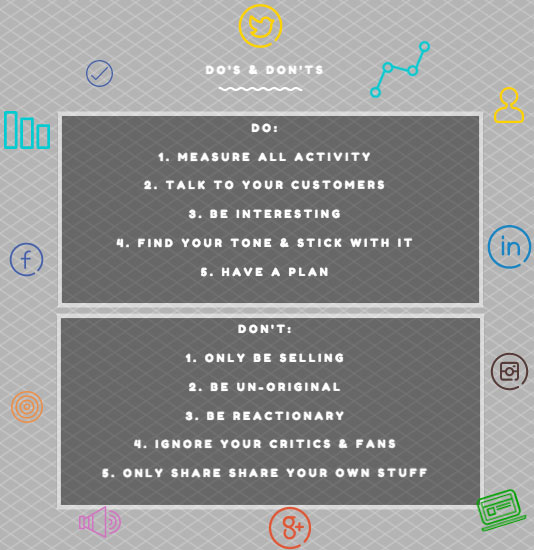
Just being a profile on social media is not enough — you need to be accurate, provide useful information, and above all else, be interesting! You want to write with “shareability” in mind and build that function into your site, allowing others to do some of the promotional work for you. When you include social media buttons on all your content you encourage more conversations, community, and more sharing.
If it gets to be too much, damolade can help build you a strategy that can include as much or as little social media as you need. We can even execute for you. We offer 20-minute free consultations, to help you define what’s right for your business with no obligation to work with us.
…let us know how we can help you by contacting us today! Leave a comment below and share some of the social media strategies that have worked for you.
If you have enjoyed this post, please take a moment to share it with your network by opening the “Share” icon below.


